Our Van - Gadgets
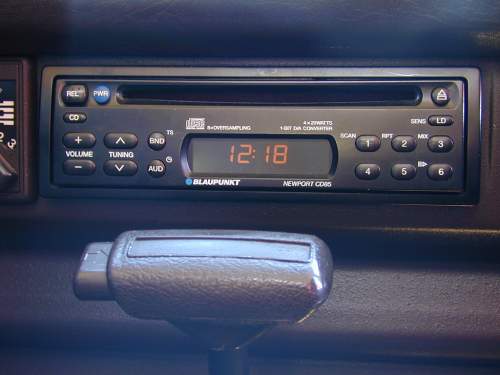 Sound System Sound SystemOur van came with the stock sound system - tiny speakers with paper cones and a Blaupunkt cassette player that didn't work. Realizing that we might want some music while traversing the open road, I decided to replace it with a Blaupunkt Newport CD player and new speakers. To power the stereo, I ran a wire forward from the deep-cycle (fuse protected, of course). The new stereo has two power inputs -- one on all the time to remember the time, stations, etc. and one that is hot only when the car is on. Vanagons don't have the 'accessory' switch on the ignition so I created one using a toggle switch under the dash. Some people wire their radios to be 'on' all the time (by tying the two inputs together) but I don't want any extra drain on my battery. With my system, when the switch is toggled 'on' I can run the radio whether the car is on or not. When the switch is off, the radio is off and there is no extra drain. |
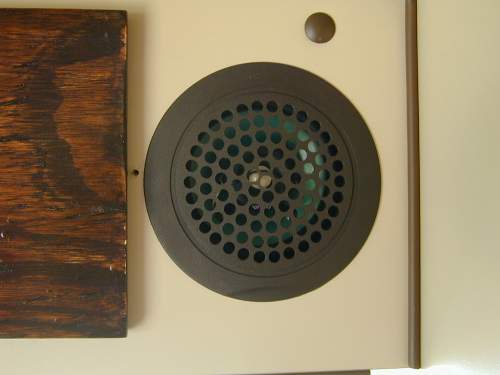 Speakers SpeakersBecause the original speakers used a common ground wire, I first had to run new speaker wire to the rear speakers. I ended up running it behind the stove and cabinets rather then try to follow where the original wires were. Although larger speakers sound better, I wanted to use the stock speaker covers and so I was limited to the original sizes (3.5" in front and 4" in the back). I chose the Infinity Kappa series because they sounded the best in the showroom. In the front, I pulled out the existing speaker holders, carefully pried out the speakers from them, bent the tabs back on the new speakers and slid them down in. To secure them, I cut slots in the speaker holder and bent the tabs into the slots - no glue required. For the rear speakers, I mounted the 4-inch speakers on the rear of the opening. Then I cut the backing off of the speaker holders and glued them back on as covers. Now, when someone looks in the window, they only see stock speaker covers and have no idea what lurks beneath. Someday I would like to add a subwoofer but I can't decide where to put it to take up as little space as possible. |
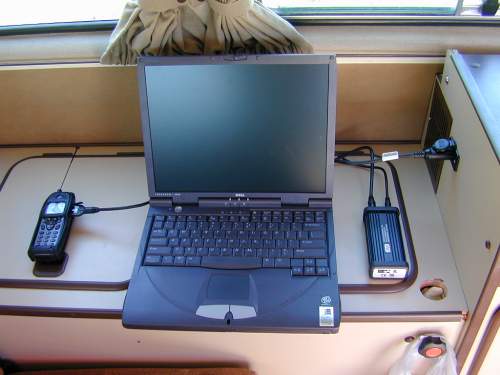 Cell Phone & Laptop Cell Phone & LaptopDriving a 15-year-old vehicle prone to mechanical failure, we decided to get a AAA Gold membership and a good cell phone. The AAA membership gave us someone to call if we broke down and the cell phone gave us the means to call. It also gave us voicemail so we could get messages from family and friends. Only Verizon and AT&T offered unlimited long distance and roaming plans. We went with Verizon because it was cheaper and I liked their phones better. Our phone is tri-mode meaning it can do analogue, digital, and data via CDMA. Data mode means we can 'surf the web' on the phone (which is interesting for about 10 minutes). What is more interesting is that with a simple cable I can connect the phone to my laptop and get 19 KB Internet access in metro areas. I can't emphasize enough how cool this is. The connection is virtually instantaneous and I don't need to have a separate ISP. We also have a pre-paid phone card but with 400 minutes per month on our cell phone we rarely use it. Of course the phone has a 12V adapter for recharging. After much deliberation we decided to bring a laptop with us on this trip. Karen wanted to be able to write, and I wanted to be able to download pictures off of the digital camera. Additionally, we are able to do email, monitor our finances, and create this website. Our insurance is all paid up for the next six months and our cell phone is automatically charged to our credit card. This means our only bill to pay each month is our VISA. I pay this using an online bill pay service through our bank. In big cities I use the cell phone to connect to the Internet but when we have access to a phone line I use a free ISP to get 56 KB access. Our email is through Hotmail so we can either download it to our computer using Outlook Express or access it from any Internet terminal. When I was shopping for a laptop, strength and reliability were more important to me than weight. This narrowed my choices to Dell and IBM. I chose Dell because I could configure exactly the computer I wanted, I had heard good things about them, and I could get a 3-year warranty. I bought a 12V adapter when I got the computer but it should be noted that this adapter draws almost 8 amps when the computer is charging and would quickly drain a normal car battery (unless the car is running). This is why I installed the Optima. For an OS, I am running Windows 2000. It has performed flawlessly from install and I strongly recommend it to anyone with a newer laptop. |
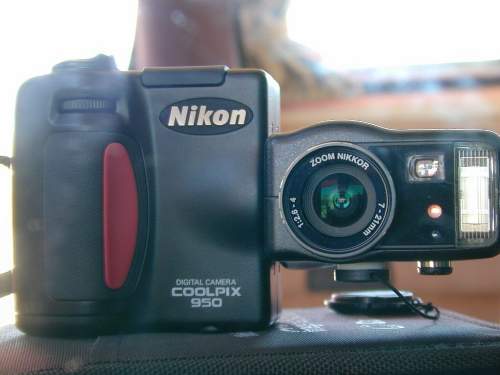 Digital Camera Digital CameraI have been into photography on and off for many years and I figured this trip would be an excellent opportunity to get back into it. On our last trip I took slide photos using an SLR camera. The photos were beautiful but I didn't get to see them until they were developed. Even then it was hard to share them with people. The advent of digital photography and the Internet seemed to resolve these issues. After much research, I decided to purchase a Nikon 950 digital camera. It is solidly built and has a number of manual overrides to allow me to fully control the exposure. It came with an 8MB compact flash card that I immediately replaced with a 32MB card. Because I am taking photos mainly for the Internet, I shoot at a lower resolution (1024x786 jpg). This allows me to take about 73 photos before I have to download the images. Compact flash cards easily connect to our laptop using an inexpensive PCMCIA adapter card and image transfer is super fast (approximately 10 sec for 30 MB of photos). The laptop has a 120 MB SuperDrive in it (like a Zip Drive but the size of a floppy). Every few weeks I back up my photos and send the disks back home. This way if my hard drive fails I won't lose my photos. |
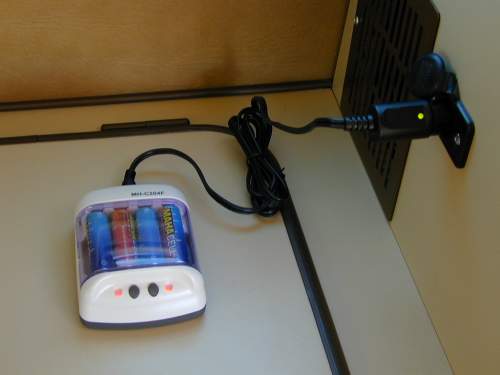 Rechargable Batteries Rechargable BatteriesDigital cameras are famous for eating batteries so I got a set of high capacity rechargeable batteries with a charger that I can plug into the 12V outlet. The charger came with 8 batteries so I always have a set charged and ready to go. With this setup, taking photos is virtually free. Because I don't have to pay for development or batteries, I have taken many more photos then I would have with an SLR (1,435 individual images as of 10/29/00). I feel this is a perfect way to improve photography skills. When you see an image you can take as many shots as you want, varying exposure settings, framing, etc. until you get the shot you want. |
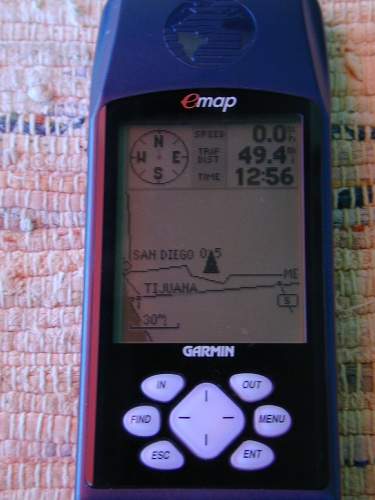 Handheld GPS Handheld GPSWhen I left my job, my co-workers gave me a hand-held GPS as a going-away present. This has been a very useful tool and has helped us find our way many times. In addition to location, it shows altitude, sunrise and sunset times for your location, exact (satellite) time, and can log interesting points. For example, our camp at Burningman this year was at N 40 44.989', W 119 13.828'. When it has several satellites in view it is accurate to 20 feet. Amazing. I can upload information to it from the laptop and it can tell us the location and heading of the nearest store or pub (perhaps the most important feature). |
Next: Parts, Suppliers, and Recommendations
Copyright 2000
Scott & Karen Semyan